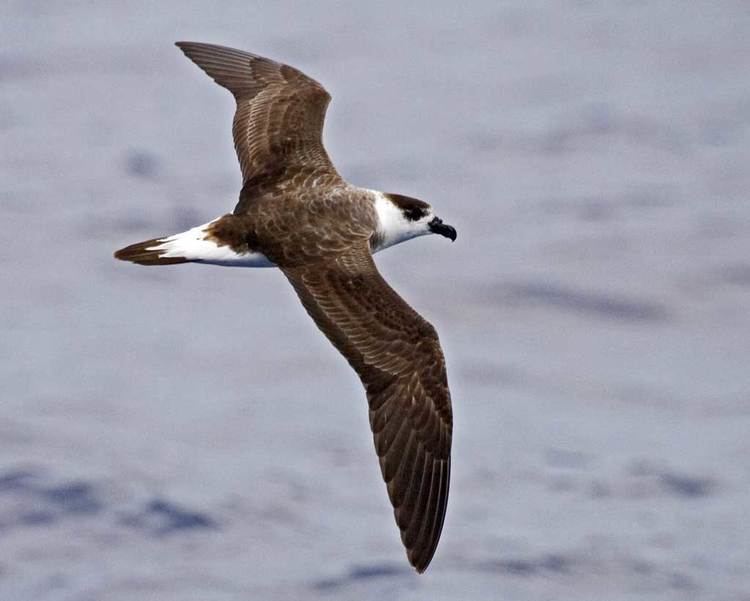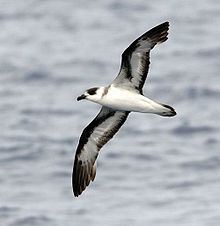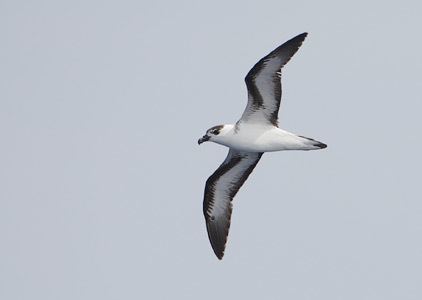Genus Pterodroma Phylum Chordata Rank Species | Scientific name Pterodroma hasitata Higher classification Gadfly petrel | |
 | ||
Similar Bird, Gadfly petrel, Audubon's shearwater, Great shearwater, Fea's petrel | ||
Black capped petrel 6th june 2006 hatteras usa
The black-capped petrel (Pterodroma hasitata) is a small seabird in the gadfly petrel genus, Pterodroma. It is also known as the diablotín. It is a long-winged petrel with a grey-brown back and wings, with a white nape and rump. Underparts are mainly white apart from a black cap (that in some individuals extends to cover the eye) and some dark underwing markings. It picks food items such as squid from the ocean surface.
Contents
- Black capped petrel 6th june 2006 hatteras usa
- Black capped petrel
- Description
- Taxonomy
- Range
- Nesting
- Conservation
- References

Black capped petrel
Description

The black-capped petrel is large compared to other gadfly petrels. The most similar species within its range is the Bermuda petrel which is smaller and has a narrower white rump patch and an extensive gray cowl. The great shearwater is also superficially similar. The probably-extinct Jamaica petrel (P. caribbaea) was a related dark form, often considered a subspecies of this bird. The local Spanish name, Diablotín, means "little devil" because of its night-time habits and odd-sounding mating calls, which may have suggested to locals the presence of evil spirits in the dark. The petrel will occasionally utter other croaks and sounds while foraging at sea.

The black-capped petrel is nocturnal on its breeding grounds, possibly to avoid predation by gulls, hawks or crows. Like most petrels, its walking ability is limited to a short shuffle to the nest burrow.
Taxonomy

There are two variants of the black-capped petrel; a dark or black-faced form, and a light or white-faced form. Genetic evidence of divergence suggests that these two color morphs represent distinct breeding populations. However, it is unclear whether these populations represent separate species or subspecies. Intermediate birds showing features of both populations are known to exist.
Range
Although this seabird once bred on steep mountainsides of the Greater Antilles, only three confirmed breeding areas remain in the high mountains of Hispaniola (in Sierra de Bahoruco in the Dominican Republic, and Massif de la Selle and Massif de la Hotte on the Haitian side of the island). In 2015, birds were also confirmed nesting on a second island (Dominica) which had long been suspected given historical nesting there. Records of Black-capped Petrels from Cuba suggest that at least small populations of these birds may also persist there. A mountain peak where it formerly bred in Haiti (and another in Dominica, Lesser Antilles) is still named "Morne Diablotin" in reference to the "little devils".
The warm waters of the Gulf Stream serve as the primary foraging area for this species. Most birds during the non-breeding season are concentrated off the United States coast between Florida and North Carolina, though they have been known to wander far to the north and east toward Europe. The species has been seen year-round in the Gulf Stream. The birds that visit these waters during the breeding season either represent non-breeders or are making long foraging trips away from the nest. The black-capped petrel is almost strictly pelagic away from the breeding grounds and is known to join loose flocks with other seabirds such as shearwaters and terns.
Nesting
Like other gadfly petrels, the black-capped petrel nests in burrows in remote highland areas of islands. These burrows are typically located on forested cliffs, and are very difficult to locate. They visit burrows at night, so as to avoid detection by predators. Eggs are typically laid in January, which will subsequently hatch sometime in March. Fledglings will then depart the nest in either June or July.
Conservation
The species, once abundant in the Caribbean, has declined significantly and is now one of the most endangered seabirds in the North Atlantic along with the bermuda petrel. In the early 20th century, there was speculation that the black-capped petrel was extinct, but more current population estimates range from 2,000-4,000 individuals. Most of the threats facing the black-capped petrel are on its nesting grounds, where causes for its demise include habitat loss, introduced predators, and direct harvesting by humans. Human predation appears to have become more limited in scope than in historic times, due in part to the species' current scarcity. Deforestation from wildfires and direct human use have likely decreased the amount of suitable nesting habitat available to the black-capped petrel. This is especially true on Haiti, which has suffered severe loss of forest cover in recent years.
Current conservation plans for the petrel largely involve preserving forest cover around known nesting areas as well as monitoring and searching for burrows. The species is currently not listed under the Endangered Species Act although there are concerns that hydrocarbon exploration off of the Southeast United States could negatively affect the species' continued survival.
